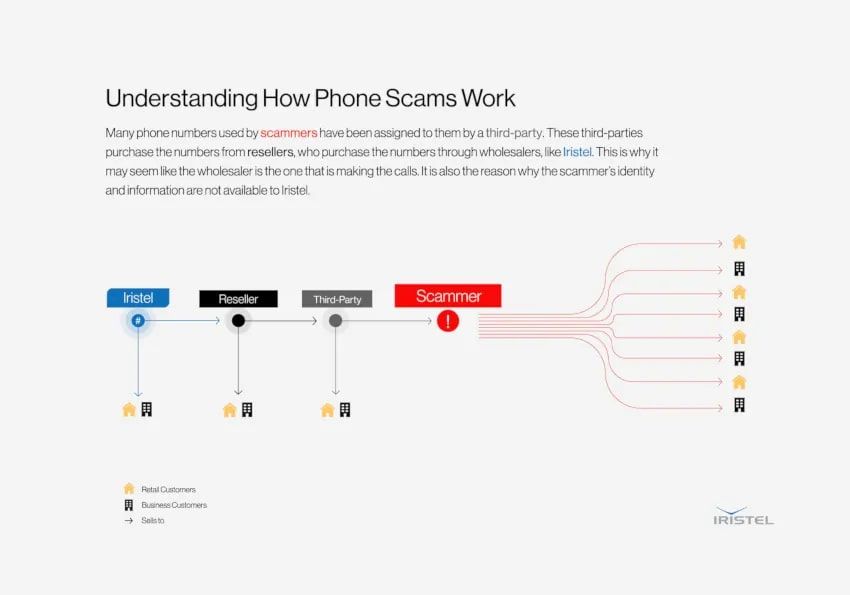Get in touch
555-555-5555mymail@mailservice.com
Informative


by Bassem Ghali
•
19 Jul, 2022
As we continue to make fundamental shifts in our lifestyle to combat the Coronavirus, this has also entailed a drastic increase in data usage across Canada and the world. This instant spike in network load has created choke points that did not exist in the past, so we are working tirelessly to address to provide you with the best possible experience. There are several significant actions you can take to enhance your data speeds and reduce network load. We thank you for your patience in light of this unprecedented situation. Read more about it here .

by Bassem Ghali
•
19 Jul, 2022
Recent events have made us even more dependent on digital connectivity. In response, Iristel and Ice Wireless are temporarily removing the throttling of data usage above the allotted plan requirements on all unlimited wireless data plans (which was previously throttled after 10GB usage on the Home network). Iristel is committed to enabling the health and well-being of our users by providing this worry-free convenience. We are all in this together.

by Bassem Ghali
•
21 Aug, 2021
While the many benefits of a cloud-based call center may be tantalizing, it isn’t uncommon for call centers to put off migration to a virtual solution until some issue forces their hand. While these situations may seem unfortunate at first, they could actually be an opportunity to improve your contact center’s performance and bottom-line. In this third part of our series, we’ll explore when it’s time to migrate your on-premise call center system to the cloud. Legacy Call Center End-of-Life First-generation legacy on-premise call centers are aging and sooner or later will have to be replaced. Expanding or upgrading on-premise equipment is expensive, and while your existing vendor may be pressuring you to buy a whole new system, this is the perfect time to look into cloud-based solutions. While these next-generation systems offer many benefits, whether on-premise or in the cloud, you need confidence a new contact center will be relatively easy to install, will perform well, and will make a decent ROI. Cloud-based call centers are easy to deploy, because it’s just a matter of getting a browser to connect to the system; the provider has already got the infrastructure ready and waiting for you to use. A traditional call center can be upgraded to an omni-channel contact center in a matter of weeks (depending on size). Call Center Hardware and/or Software Upgrades Even if your on-premise call center is not yet at the end of its’ productive life, it may be time to upgrade, perhaps to keep the call center software up to date, to add new features, or to integrate with other channels or systems. If you are maintaining different contact center systems at different sites, you may need to juggle upgrades between sites to minimize downtime. If you are questioning whether the benefits of upgrading your old system are worth the risk, hassle, and cost, you could consider a hybrid solution, which can provide all the latest features and channels, in addition to unified cloud routing, predictive analytics-based routing, and a graceful migration path to the cloud. This is particularly valuable to multi-site, multi-system contact centers. Moving or Relocating Call Centers There are many reasons why a business needs to relocate – more space, a better location, financial necessity among them. Whatever the case for the move, it might be a good time to leave your old call center system with your old address. Since cloud-based systems are easy to deploy, and much less expensive in terms of up-front capital expenditures, it might actually be cheaper and/or easier to have your new cloud-based call center ready and waiting for you in your new digs. Growing and Scaling Your Call Center If you must have a problem, growth is a relatively good problem to have. At the same time, if your call volume, number of agents, distributed sites, or outsource partners are increasing, it can lead to other problems that aren’t so good to have, such as difficulty scaling your old system, and difficulty controlling and managing the needed expansion. If you upgrade a traditional call center, you have a big capital expense up front for licenses and equipment, and you may still be limited by the number of ports you have. With a virtual call center, the upfront cost is considerably less, and you will never have to worry about managing and maintaining equipment going forward. In addition, the better cloud-based solutions are scalable from small, middle, and up through large enterprises. New Contact Center Features With all the advances in communications and contact center technology, there will be times you need to add new features to stay competitive. While you may be able to get the features you need from your legacy on-premise contact center vendor, how much more will it cost? Does that include the cost of the people implementing the new features? Virtual call center solutions allow you to get the latest innovations, features, and upgrades faster and at a lower cost. Going forward, you won’t have to manage upgrades, because the cloud service provider does that for you. Integrating Your Call Center With Other New Systems Even if you haven’t migrated your on-premise call system to the cloud, other SaaS platforms, such as a CRM (Customer Relationship Management) can enter the scene at your company. While software such as Salesforce might easily integrate with a cloud-based call center, it might not integrate so easily with an old on-premise system. Modern cloud-based contact center software provides a unified solution that uses open standards to easily integrate your data, voice, applications, and databases. Contact Center Service Quality Customers respond negatively to unreliable situations. Maintaining reliability requires managing uptime and service levels across systems and sites, knowing when things are working and not, and having insight into peak times, loads, and other analytics across all systems. This can be challenging with on-premise equipment. If your reliability and service levels are suffering, you can migrate to a cloud-based solution, which can provide up to 99.99% uptime while balancing call loads and ensuring the most efficient use of agents in multiple locations. Contact Center Business Performance 10 years ago the priority was cost reduction, but in today’s competitive environment the focus is on improving business performance through key performance indicators (KPIs). Today’s disparate and distributed systems are not delivering the needed collaboration and integrated views to improve the two categories of KPIs: operational and business. A cloud solution with predictive analytics-driven routing can improve business performance, as well as operational efficiency and costs. The unified user experience and centralized performance data across channels and systems some cloud contact center systems provide allow agents to provide better service, and managers to better understand and manage operations and business performance. Combining Call Centers Due to Acquisition or Merger We’ve all been through it – a company gets bought or sold, and not only do departments have to merge functions across the new enterprise, but call center systems that were originally not designed to work together now have to. You can try to keep the original systems and teams working separately, but it’s difficult to manage and optimize in real-time with no unified view or control of multiple sites or systems. An alternate solution is to create a hybrid cloud contact center, which overlays some of your existing systems to unify and correlate metrics from the multiple systems and sites. The more sophisticated cloud-based contact centers have the capability of displaying cross-system, channel, and site operational and performance metrics – in real-time. These next-generation cloud call center systems can also drive the behavior of on-premise systems, letting you create centralized routing rules across sites and technologies. In time, you can gradually migrate some sites to the cloud. In summary, challenging situations can arise that are really opportunities for you to take stock of your existing call center and improve your business by migrating to the next generation of contact center functionality.

by Bassem Ghali
•
13 Dec, 2017
Every year there seems to be a new phone scam aimed at taking money from unsuspecting, often vulnerable, people. For the last several years, the CRA scam has been making the rounds, but there are countless others that are featured less prominently in the news. Through our customer support center, we’ve probably been asked about all of them, and while we don’t have all the answers, hopefully we can shed some light on some the most frequently asked questions. Who’s Calling Me? That’s the big question, and unfortunately, one we can’t answer. With most phone scams, the number used to make the call has been assigned to a reseller. Meaning, that it was purchased from us and then sold to someone else whose information we can’t access. In other cases, the number may be “spoofed,” so what you see on your display isn’t actually where the call originated. These calls may not even be routed through our network, or made from within Canada. Can’t You Just Block the Number? Assuming we knew where the call was coming from, unfortunately it still wouldn’t be that simple. There are countless laws and regulations that prevent us from blocking or disabling a number, or even providing information about who a number was assigned to. For example, regulations require that we notify a customer before suspending service. Scammers change numbers so quickly, that as soon as the process begins, they’re operating under a new one. It’s like playing whack-a-mole – as soon as you get one, a new one pops up. With that said, if we could, we would. In addition to the millions of dollars taken from innocent Canadians, telephone frauds cost Iristel thousands of dollars every year in support costs; the CRA scam is the number one reason for calls to our abuse and security hotline. Is There Any Way I Can Block the Number? You can call your personal telephone provider and ask them to block the number. Likewise, if you are an Iristel customer, we will gladly block the number for you, and provide you with self-serve tools that allow you to manage your account. Please keep in mind that if the number is spoofed we may not be able to help. The difference is that because it only affects you personally, it doesn’t violate the same laws and regulation that prevent us from universally blocking the caller. What is Iristel Doing? We work with the Canadian Anti-Fraud Centre (CAFC) to help prevent and disrupt phone scams. In 2016, we received over 200 requests from the CAFC, who has the authority to obtain information from resellers and investigate criminal activity. What Should I Do if I Receive a Call? The safest thing to do is hang up immediately. Don’t engage with the caller, and never give out personal or financial information over the phone. If you are the victim of a phone scam or suspect that you were targeted, please do one of the following: File a complaint with the CRTC by calling 1-877-249-2782 Report the incident to the Canadian Anti-Fraud Center online or by calling 1-888-495-8501 Otherwise, the best way to stop a scam is to spread awareness. Tell your family, friends and neighbours. This isn’t something that will go away overnight, but if you still have any questions or concerns, please email us at feedback@iristel.com and we will be glad to help in any way we can.

Iristel Africa-Kenya
The Mirage Towers, Tower 1 8th Floor, Chiromo Road Westlands, Nairobi, Kenya
57078-00200
Customer care: 9AM - 9PM EAT
+254 (20) 8784747
Ext (4740 or 4742)
Iristel Global Headquarters
675 Cochrane Drive
East Tower, 6th Floor
Markham, ON, Canada, L3R 0B8s
Customer care: 9AM - 9PM EST
Inside Iristel
Subscribe for exclusive offers and the latest news from Iristel!
Resources
Iristel Inc. 2022 © All rights reserved.
Smart Site Design & SEO Services by Green Lotus Agency

